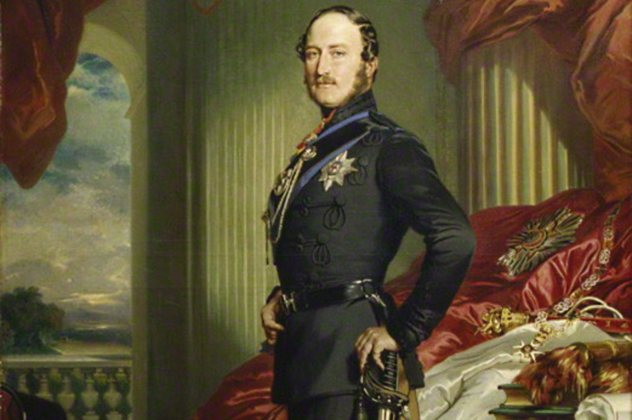 Technology
Technology  Technology
Technology  Humans
Humans 10 Everyday Human Behaviors That Are Actually Survival Instincts
 Animals
Animals 10 Animals That Humiliated and Harmed Historical Leaders
 History
History 10 Most Influential Protests in Modern History
 Creepy
Creepy 10 More Representations of Death from Myth, Legend, and Folktale
 Technology
Technology 10 Scientific Breakthroughs of 2025 That’ll Change Everything
 Our World
Our World 10 Ways Icelandic Culture Makes Other Countries Look Boring
 Misconceptions
Misconceptions 10 Common Misconceptions About the Victorian Era
 Mysteries
Mysteries 10 Strange Unexplained Mysteries of 2025
 Miscellaneous
Miscellaneous 10 of History’s Most Bell-Ringing Finishing Moves
 Technology
Technology Top 10 Everyday Tech Buzzwords That Hide a Darker Past
 Humans
Humans 10 Everyday Human Behaviors That Are Actually Survival Instincts
 Animals
Animals 10 Animals That Humiliated and Harmed Historical Leaders
Who's Behind Listverse?

Jamie Frater
Head Editor
Jamie founded Listverse due to an insatiable desire to share fascinating, obscure, and bizarre facts. He has been a guest speaker on numerous national radio and television stations and is a five time published author.
More About Us History
History 10 Most Influential Protests in Modern History
 Creepy
Creepy 10 More Representations of Death from Myth, Legend, and Folktale
 Technology
Technology 10 Scientific Breakthroughs of 2025 That’ll Change Everything
 Our World
Our World 10 Ways Icelandic Culture Makes Other Countries Look Boring
 Misconceptions
Misconceptions 10 Common Misconceptions About the Victorian Era
 Mysteries
Mysteries 10 Strange Unexplained Mysteries of 2025
 Miscellaneous
Miscellaneous 10 of History’s Most Bell-Ringing Finishing Moves
10 Terrible Diseases That Ravaged Historical Royalty
Sometimes, we forget that diseases have always been here. They don’t simply pop into existence when a set of symptoms are given a name and declared a disease. Royal families are no more exempt from serious conditions or genetic weaknesses than anyone else. Because of their important status, however, their recorded histories hold some of the oldest case records of medical problems. The blue bloods on this list date back from a few hundred to a few thousand years. Based on their symptoms and the diseases we know today, previously unknown health failures can now be tentatively given a modern name. Other conditions, while known at the time, were not understood very well.
10 Queen Victoria

While her status as the first known carrier of hemophilia is well documented, few realize just how devastating the spread of Queen Victoria’s genes were on the next three generations that followed her. Two of her daughters and four of her granddaughters were carriers of the disease. A son, three grandsons, and four great-grandsons were all sufferers, most of whom bled to death. Since her children eventually married into other politically important wealthy bloodlines, Queen Victoria’s genes weakened the royal houses of England, Russia, Spain, and Prussia.
While she was the first documented carrier in the British royal family, her son, Prince Leopold, was the first sufferer. Hemophilia doesn’t appear to have turned up before Victoria, and the theory is that the trouble started with a mutated gene in her father, Edward Augustus, Duke of Kent. The “royal disease,” as it is sometimes known, is attached to the X chromosome as a recessive gene. Since women have two X chromosomes, they’re very unlikely to suffer from hemophilia, only carry it. The X chromosome with the recessive hemophilia gene will be dominated by the other X. It’s possible for both of a woman’s X chromosomes to carry the hemophilia gene, which would cause them to suffer symptoms, but it’s statistically unlikely. Should males, with only one X chromosome, inherit the gene, they will be full-blown bleeders. Due to missing proteins, their blood can’t clot, and they can bleed to death from even a minor cut. Perhaps the most famous of Queen Victoria’s hemophiliac descendants was her murdered great-grandson Alexis Romanov, the future tsar of Russia.
9 Prince Albert

Prince Albert Saxe-Coburg-Gotha was the husband and first cousin to Queen Victoria. He died young and unexpectedly at the age of 42 in December 1861. The distraught queen forbade an autopsy, which could have determined the caused of the royal consort’s death with more certainty. Something needed to take the blame, and for the last 150 years, typhoid got the stick.
More recently, Oxford historian Helen Rappaport’s research suggested that the prince had actually died from Crohn’s disease. Crohn’s is an inflammatory bowel disease that affects one out of every 500 people. Although it’s treatable today, sufferers in the 1800s had no cure or even knowledge of the disease’s existence. It wasn’t described until 1932 and was often fatal. Symptoms include painful abdominal troubles, which Prince Albert battled for months before his death. Doctors at the John Radcliffe Hospital also re-examined the medical evidence and agreed that the prince was more likely a Crohn’s sufferer than a typhoid victim.
8 King James I

In 1566, James was barely one year old when he was crowned King James VI of Scotland. When the childless Queen Elizabeth died, he also took the English crown and became King James I of England. Until he was five, James struggled to walk unassisted. It’s possible that he had a hereditary neuromuscular disease, since he shared his frail and thin legs with both his father and one of his sons.
The hereditary disease porphyria manifested in some of his descendants, and James certainly had the symptoms. Fever, stomach upset, and pain, during which his urine was wine-dark, were all in line with porphyria, a disease that occurred in episodes, two of which his personal physician recorded in 1613 and then again in 1615. Insanity is also a symptom, which he arguably displayed plenty of. When hunting, James would tear open a deer’s belly and put his hands and feet inside the animal before disturbingly slathering its blood all over the rest of the hunting party.
During his golden years, James was crippled by severe arthritis, became skeletal, and had sores on his mouth. His mental problems were now permanent, an early onset of dementia that may have been caused by several small strokes. He was like a child, couldn’t recognize people, and was in no state to make royal decisions. He died in 1625, amid symptoms of porphyria and an inability to talk or swallow.
7 King George III

King George’s madness is well known and, given his family’s medical history, possibly caused by variegate porphyria, a type of porphyria that was symptomatically displayed in his ancestors, James VI of Scotland and Mary, Queen of Scots. But, whereas James was a milder case and given kingly consideration during his bouts with this distressing disease, an acute form struck George III, who was tied to a chair for hours and eventually kept in inhumane conditions at Windsor Castle.
The disorder occurs when a specific enzyme is missing during the production of hemoglobin in red blood cells. As a result, porphyrins are overproduced. This buildup causes a wide range of symptoms, including abdominal trouble, nervous system issues, madness, skin sensitivity, and dark urine. George III became violent and rambled for hours during his bouts but also had remission periods when he could rule normally for years.
In 1810, he suffered a devastating episode. He didn’t recognize his wife, Queen Charlotte, and the king was hidden away from society. For the last 10 years of his life, he was held at Windsor Castle, disheveled and uncared for, while his son acted as regent. To add to his suffering, he went blind and deaf. In 1819, perhaps mercifully, the king died after a particularly bad porphyria attack.
6 King George V

King George V isn’t particularly notable for suffering from misunderstood symptoms, but new knowledge about his death is certainly intriguing. George V had reigned for 25 years and was also the royal responsible for changing the ruling house’s name from Saxe-Coburg-Gotha to Windsor. The reason for his passing in 1936 was officially listed as pleurisy. It was certainly true that he had the condition, but that’s not what killed him. The king was euthanized.
Lord Dawson, the royal physician who administered the fatal cocktail of drugs, kept notes of the events that lead up to that moment. According to the Dawson notes, still kept in the archives of Windsor Castle today, the doctor was told by the 71-year-old monarch’s wife (Queen Mary) and his son (the future abdicator Edward VIII) that they did not want the king to suffer if his condition was fatal. Since Dawson recorded no mention that the king was included in this decision, the line between murder and a mercy death turns rather blurry. The doctor also timed George’s death so that it would get the maximum exposure in the morning newspapers and not the evening edition. Around 11:00 PM on January 20, the comatose king was injected with a fatal amount of morphine and cocaine, but the end wasn’t instant. It took him nearly one hour to die.
5 Tsar Ivan IV

Ivan The Terrible remains one of the most brutal leaders in the memory of mankind. He might have been plainly sociopathic, but one disease probably caused or worsened the tsar’s murderous nature. When his remains were re-examined in the 1960s, they were found to be laced with mercury. He suffered from rheumatoid arthritis, and the bones showed signs of syphilic ostratis. A tsar always stood the chance of being poisoned, so the possibility that somebody finally got tired of Ivan and served him the deadly mercury cannot be dismissed. However, back then, mercury was also a treatment for the final stages of syphilis, a disease that often brings on the kind of arthritis that Ivan had.
It’s not hard to imagine how he contracted the venereal disease. If there was an Oscar statue for promiscuity, he would’ve won many. He took both sexes to bed, mostly against their will. His personality change is also reminiscent of syphilis. When he became ruler, he was intelligent and peaceful. But as the years progressed, paranoia and rage turned him into a sadistic torturer and serial killer of note, his victims including several close friends and even his son. Ivan sacked his own cities, massacred the inhabitants, and insanely gave speeches on Christian values at parties where he and his ilk tortured people to death.
Mercury poisoning and tertiary syphilis both cause episodes of violence. Some say his behavior stemmed from severe childhood abuse and the loss of his coveted wife, but considering that abuse survivors and bereaved spouses don’t generally sack their own suburbs, that theory doesn’t hold up. Ivan died in 1584.
4 King Richard III

The long-missing remains of Richard III have been found in a Leicester parking lot in recent years, and the skeleton matched many historical references. The horrendous wounds that marred the bones supported the fact that he was the last English king to die in battle, and spinal anomalies confirmed the stories that he was handicapped. After looking at the king’s vertebrae and spine, markedly deformed with a deep curvature, it was found that Richard had a condition known as idiopathic adolescent onset scoliosis. It was most likely progressive, beginning in his teens and worsening as he aged. In life, his left shoulder would’ve been much lower than the right and from the pressure scoliosis exerts on the lungs, he would’ve suffered from breathing problems as well. The deformity also made him much shorter than the 172-centimeter (5’8″) stature he would’ve had in perfect health.
There were no signs of the other deformities that some stories attribute to Richard. Born in 1452 and very unlikely to reach the throne (being the 12th child), Richard was crowned after the suspicious disappearance of his 12-year-old nephew, King Edward V, and his brother. He ruled for two years, dying in 1485 during the Wars of the Roses, fighting against the men of Henry Tudor (the father of Henry VIII).
He was apparently buried with little respect. The grave was too small and badly dug. There was no sign of a coffin, and by the looks of it, his hands might have been tied. Buried at the church at Greyfriars, his grave disappeared when Henry VIII dissolved the monasteries. The University of Leicester matched the DNA from the remains to living descendants, and King Richard III was reburied in Leicester Cathedral.
3 King Henry VIII

This Tudor king, famous for killing some of his wives, desperately wanted a male heir. It is believed that he caused up to 13 pregnancies with six wives and untold mistresses, of which only four resulted in live births. Research shows that it’s possible that the king’s blood was to blame. He might have had the rare Kell antigen, a protein that weakens the immune system, causing stillbirths, miscarriages, or death soon after birth.
If that was the case, then McLeod syndrome fits with his bad health and even worse behavior. McLeod syndrome is a genetic disorder that affects only Kell-positive individuals. Mentally, it brings on dementia, which might explain why Henry VIII went from being a relatively benevolent guy to a chopper of wives’ heads and executioner of anyone whom he suspected was against him. The disease also degenerates muscle tissue, and by the time the king hit middle age, he could barely walk. Some suggested that he was instead a syphilis sufferer, but his track record with sickly pregnancies partners better with McLeod syndrome.
2 Queen Mary I

Queen Mary I was a daughter that would’ve done her bloodthirsty father, King Henry VIII, proud. Her tendency to burn people at the stake earned her the name “Bloody Mary.” Born in 1516, she was crowned queen after her half-brother, King Edward, died at the age of 15. To ensure the succession of her own line, Mary had to produce an heir, so she married her love, Prince Philip I of Spain.
In September 1554, doctors declared the queen pregnant, she was treated for morning sickness, and her belly grew. But 11 months later, she still hadn’t given birth, and when she left her confinement room and appeared at court again, her body was nearly emaciated. When she was 42, Mary was certain that she was pregnant again, but the same thing happened. After the second “pregnancy” symptoms disappeared, her health went into a decline from which she would never recover, dying from the flu about a year later.
Several conditions could’ve caused this heartbreaking condition for the queen, who only wanted to be a mother. One is pseudocyesis, better known as a “phantom pregnancy.” What causes it is still not fully understood by medical science, but it’s possible that her intense longing for a baby might’ve contributed. A much more serious diagnosis would be that she was a cancer sufferer, possibly ovarian cancer. She may also have had a reproductive cyst, which manifested the pregnancy-like symptoms.
1 King Herod

King Herod appears in the New Testament as the cruel, insecure ruler of Judea, who ordered the deaths of every baby boy in Bethlehem in an attempt to kill the infant Jesus. Curious about what had caused the death of this biblical King, Dr. Jan Hirschman from the University of Washington decided to perform an autopsy. Since Herod died over 2,000 years ago and nothing remains of the royal, the autopsy was more of a marriage between modern medical knowledge and the studying of ancient records.
Hirschman considered the writings of Flavius Josephus, born about a century after Herod, who had scoured the notes written by the king’s court historian, Nicholas of Damascus. The symptoms Herod displayed during his final illness included a fever, all-over itching of the skin, abdominal discomfort, genital gangrene, asthma, convulsions, and bad breath. Going on the trail of diseases that can cause severe itching, Hirschman checked to see which one of those also matched the king’s other symptoms.
The most likely winner was chronic kidney disease, although Hirschman couldn’t say for how long it afflicted the king. A condition known as Fournier’s gangrene, a genital disease, was likely induced by Herod himself. As he tried to ease the nonstop itching with nonstop scratching, it lead to a possibly untreated infection, and the dreaded rot began. It’s been suggested that the gangrene was from gonorrhea, but without a body, the origins of the gangrene cannot be ascertained. Once Fournier’s set in, the king would’ve died within days or weeks.








